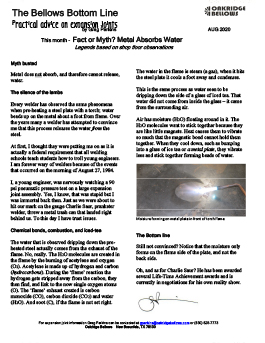Fact or Myth? Metal Absorbs Water

Myth busted
Metal does not absorb, and therefore cannot release, water.
The silence of the lambs
Every welder has observed the same phenomena when pre-heating a steel plate with a torch; water beads up on the metal about a foot from flame. Over the years many a welder has attempted to convince me that this process releases the water from the steel.
At first, I thought they were putting me on as it is actually a federal equirement that all welding schools teach students how to troll young engineers.
I am forever wary of welders because of the events that occurred on the morning of August 27, 1984.
I, a young engineer, was nervously watching a 90 psi pneumatic pressure test on a large expansion joint assembly. Yes, I know, that was stupid but I was immortal back then. Just as we were about to hit our mark on the gauge Charlie Saur, prankster welder, threw a metal trash can that landed right behind us. To this day I have trust issues. Chemical bonds, combustion, and iced-tea
The water that is observed dripping down the preheated steel actually comes from the exhaust of the flame. No, really. The H2O molecules are created in
the flame by the burning of acetylene and oxygen (O2). Acetylene is made up of hydrogen and carbon (hydrocarbons). During the ‘flame’ reaction the hydrogen gets stripped away from the carbon, they then find, and link to the now single oxygen atoms (O). The ‘flame’ exhaust created is carbon monoxide (CO), carbon dioxide (CO2) and water (H2O). And soot (C), if the flame is not set right. The water in the flame is steam (a gas), when it hits the steel plate it cools a foot away and condenses.
This is the same process as water seen to be dripping down the side of a glass of iced tea. That water did not come from inside the glass – it came from the surrounding air.
Air has moisture (H2O) floating around in it. The H2O molecules want to stick together because they are like little magnets. Heat causes them to vibrate so much that the magnetic bond cannot hold them together. When they cool down, such as bumping into a glass of ice tea or a metal plate, they vibrate less and stick together forming beads of water. Moisture forming on metal plate in front of torch flame.
The Bottom line
Still not convinced? Notice that the moisture only forms on the flame side of the plate, and not the back side.
Oh, and as for Charlie Saur? He has been awarded several Life-Time Achievement awards and is currently in negotiations for his own reality show.


